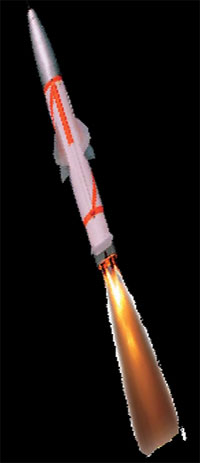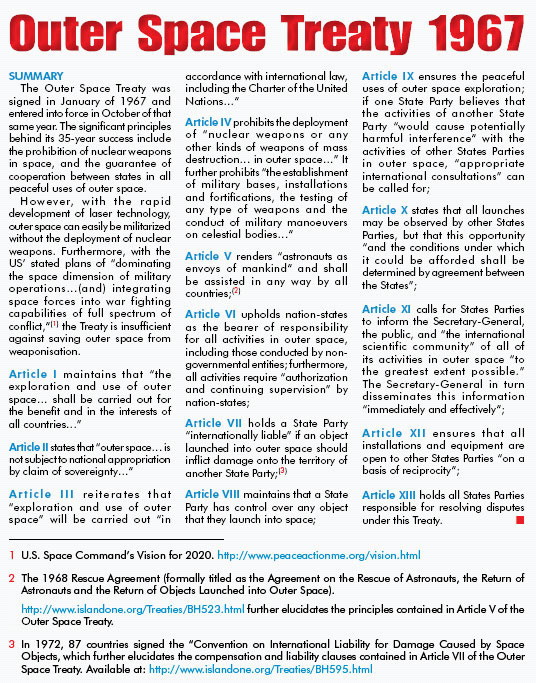|
 In
January 2008, China demonstrated its ability to
physically destroy a satellite in space by firing
a missile at it. Even though the satellite that
had been shot down was an ageing satellite, the
act sent a chilling message to the world. Later,
the United States proved similar capability. In
January 2008, China demonstrated its ability to
physically destroy a satellite in space by firing
a missile at it. Even though the satellite that
had been shot down was an ageing satellite, the
act sent a chilling message to the world. Later,
the United States proved similar capability.
A headline in the Jane’s Defence Weekly a few
years ago had stated: “USAF Eyes Relay Mirrors
to Extend Range of Lasers”. In bold type-face
the first paragraph of the news item datelined
Washington D.C. had proclaimed ominously: “Highpowered
laser weapons are expected to make their operational
debut later this decade, according to military
planners who say these weapons will revolutionise
future battles by giving US forces the ability
to hit targets with lethal beams of energy delivered
at extreme speed and over great distances.” The
deployment of weapons systems will turn outer
space into a potential battlefield – a platform
from which to seek strategic superiority on the
ground. Space is fast acquiring the status of
the ultimate high ground, a term much revered
by military planners and leaders.
Which way is the West led by United States (US)
headed? Is it Ronald Reagan’s Star Wars programme
all over again? Or, is it, as some analysts have
dubbed it, the “son of Star Wars”? The plans now
underway to utilise high-flying airborne lasers
on board modified Boeing 747 aircraft to generate
multi-megawatt laser beams that are then reflected
by a relay of 5-metre diameter mirrors arrayed
in outer space to shoot down nuclear-tipped ballistic
missiles during their boost phase, will lead inexorably
to the weaponisation of space.
India is also now a major space power with substantial
civilian and military stakes in space and must
decide whether it wishes to support and join the
current race to weaponise space or oppose it.
US Race for Space
According to the Washington Post, in January
2001 the US Air Force Space Command completed
a major war-game set in space where “attack satellites
and lasers fought computer hackers and space planes
in a simulated struggle reflecting the Pentagon’s
growing belief that the key battles of the 21st
century may be fought in space.” The exercise
called “Schriever 2001” showed that the “ability
to project force to and from space can be a powerful
deterrent to conflict.” The US Army is not far
behind and is looking to exploit emerging space
technology to deliver “effects-based fires” for
manoeuvre on the future battlefield. How exactly
they intend to achieve such effects is hazy at
present.
The next logical step would inevitably be to
develop capabilities to destroy similar systems
of the adversary in space including military satellites.
US Senator Tom Harkin had said after a 1997 laser
test to help the US military understand the vulnerabilities
of military satellites that the test was “both
unnecessary and provocative.” Quite obviously
since then, the US military has gradually come
to accept space as a future battlefield and a
new theatre of operations. The world will soon
hear about killer satellites armed with lasers,
space mines, electronic jamming systems and logic
bombs and viruses that can cripple computer-based
command, control, communications and intelligence
systems.
The aim will be to destroy satellites or neutralise
them temporarily through non-lethal means. These
could include lasers to blind imaging satellites
and radio-signal jammers, and even chemical means
to disable a spacecraft in flight. The fight will
undoubtedly also extend to the destruction of
enemy ground control facilities, both from the
air and from space. Also on the drawing boards
is a strategic space bomber that will blast off
like a ballistic missile and drop precision-guided
munitions from the stratospheric height of up
to 100 km on targets deep inside enemy territory.
It will be capable of reaching any target anywhere
in the world within 30 minutes of takeoff from
the continental United States.
The US Department of Defense issued a Directive
on Space Policy (July 9, 1999), which declared
space as “a medium like the land, sea and air
within which military activities shall be conducted.”
The Year 2000 Commission to Assess United States
National Security Space Management and Organisation,
chaired by Defence Secretary Rumsfeld before he
was nominated to head the Pentagon, had warned
of a Pearl Harbour in space. In its report, the
Committee had said it would be in the national
interest to “develop and deploy the means to deter
and defend against hostile acts directed at US
space assets and against the use of space hostile
to US interests.”
The US Air Force, eager to rename itself an “aerospace
force”, launched a new study in 2001 to identify
research areas to focus on space control and space
access with a view to conducting effective aerospace
operations.
Present US efforts focus primarily on enabling
the armed forces to control space to leverage
the military potential of this vital medium to
protect troops and territories and project power
abroad. However, it must be noted that US policy
planners and space industry officials are now
calling for an “overarching strategic plan that
would coordinate civil, military and commercial
space efforts.” The practical realisation of these
diabolical capabilities will be extremely destabilising
for world peace. Their possession by the US will
naturally compel Russia and China and maybe half
a dozen other countries to follow suit – leading
to a second race for space, after the first one
was sparked by the launch of the USSR’s Sputnik
in the 1950s.

Treaty Violations
After several decades of successful space exploration
the commercial exploitation of space has now become
a big-ticket business.
Many nations and multinational corporations now
have sensory and communications satellites in
space. Space is also being used for navigational
and positional applications and remote sensing.
Over the l a s t 30 years the commercial space
market has spun off many military uses and, hence,
most militaries the world over have become heavily
dependent on the use of space for telecommunications,
satellite-based imagery and reconnaissance and
navigation. Military leaders and national security
analysts in the West are now of the view that
space-based weapons are now inescapable.
Plans that are now underway for the military
use of space will negate the Outer Space Treaty
and the Anti-Ballistic Missile Treaty. The Outer
Space Treaty of 1967 bans the deployment of weapons
of mass destruction in space. The 1972 Anti-Ballistic
Missile Treaty, all but unilaterally abrogated
now because of the ongoing US programme to develop
missile interceptors, enjoins the signatories
not to deploy antiballistic missile interceptors
in space. The abrogation of these treaties does
not augur well for future arms control and disarmament
negotiations.
Related Developments
Former Russian President Vladimir Putin had expressed
serious concern over the increasing militarisation
of space and called upon the world community to
“redouble its efforts to preserve a peaceful outer
space for the sake of future generations.”
China had called for a ban on the testing, deployment
and use of all weapons, weapons systems and their
components in outer space before its anti-satellite
test. It had suggested the establishment of a
UN committee to draw up a binding international
instrument to prevent an arms race in outer space.
While China consistently downplays any military
application of its own space programme, recent
developments including renewed emphasis on manned
flights (Project 921) nevertheless indicate the
increasing important of space in China’s national
security planning. Project 921 quite obviously
has military connotations.
In Israel, the Air Force has been designated
as the lead service for the operational planning
and eventual deployment of space assets and related
systems and for the expanded military use of space.
India has consistently opposed the military use
of space. Addressing an ESCAP-sponsored Space
Applications conference in November 1999 at New
Delhi, Prime Minister Atal Behari Vajpayee had
said: “I cannot overemphasise the need for developing
space applications for global peace and security.
Space must become the newest frontier not for
an arms race but for humankind’s collaborative
and common race for development.” At the Space
Summit of the Indian Science Congress at Bangalore
in early January 2003, then President, Dr A P
J Abdul Kalam had called for the establishment
of an “International Space Force” to ensure that
conflict on earth does not spill over into space
or harms the space assets of mankind.
Today it sounds like Utopian thinking.
It is difficult to accept the argument of space
as an inevitable battlefield. There is no tangible
evidence of the development of space-based weapons
and strategies by the socalled “rogue states”.
There is no immediate threat on the horizon and
it may be several decades before such a threat
actually materialises. Practical weaponisation
of space is unlikely till about 2020 at least.
Also, at present, planned spacebased weapons
capabilities can be more cheaply and almost equally
effectively delivered by land-based weapons platforms.
The international community must utilise that
time interlude to lead a fight to honour the Outer
Space Treaty of 1967 – if at all such a course
of action is still practicable. A major step forward
would be to seek a general and wideranging ban
on weapons in space. As a leading player on the
international stage and as a major space power
itself, India must play a substantive role in
this noble venture.
Famous Cold War analyst Raymond Aron had observed
with quiet resignation: “Short of a revolution
in the heart of man and the nature of states,
by what miracle could interplanetary space be
preserved from military use?” When Robert Browning
wrote, “Man’s reach should exceed his grasp/ otherwise
what is heaven for?” he could not have imagined
that man will one day attempt to dominate the
heavens. Mankind’s last frontier must never be
allowed to become the last battlefield between
nation-states. There is hope yet if the international
community makes concerted efforts and public opinion
– the second superpower – can be aroused to oppose
the militarisation of space.
However, the Indian government must make its
own calculations about whether or not the weaponisation
of space is inevitable. If it concludes that the
West and China are going down that route, it must
lose no further time in sanctioning a tri-Service
aerospace command and giving it a wide-ranging
charter to develop and field Indian weapons in
space. This is one field in which no friendly
nation or strategic partner will transfer technology
to another.
|